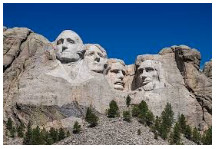 PRESIDENT'S CORNER:
Hello SDAG Members,
It's hard to believe this year is already coming to an end! Time has flown by, and I hope you all have enjoyed our variety of speakers and topics we've had this year!
As I reflect on our journey this year, it has given me immense joy being your president, from hosting our monthly meetings, especially getting to know each of you all
more, preparing a field trip guidebook on the San Andreas fault with an amazing field trip committee, finally being able to have our annual field trip in September 2025
(after it was postponed in 2024), coordinating with so many talented speakers, and now getting ready for our traditional holiday celebration at The Nat!
We had a wonderful joint meeting with AEG-Inland Empire for our November meeting held at The Old Spaghetti Factory in San Marcos. Thank you, Eldon Gath, for presenting a
very captivating and well-executed talk on Orange County's tectonic geomorphic evolution! The way you walked us through the geologic history of the area, covering
numerous lines of evidence, in just an hour was merely impressive! Hopefully Eldon's recorded presentation is shared with students and inspires some of them to do a
master's thesis or two! The recording will be available soon on our website. Thanks again, John Teasley, for recording it!
Next, please join us for our traditional holiday celebration on December 17th in Balboa Park at the San Diego Natural History Museum (The Nat) with none other than,
Dr. Tom Deméré, Curator of Paleontology and Director of PaleoServices!! Tom Deméré will give a presentation on "150 years of Paleontology at
the San Diego Natural History Museum." Don't wait, make your reservation NOW!! Last day to sign up is Wednesday, December 10th!
I have some exciting news to share! Please welcome, Mike Palmer, as our 2025 SDAG Vice President!! Also, copies of the 2nd printing of our 2025 SDAG Field Trip Guidebook
"San Andreas fault: Exploring Quaternary Geology Along the Big Pines Highway, Wrightwood, CA" will be available for purchase at our December meeting!!
If you, or someone you know, are interested in becoming an SDAG officer in 2026 please reach out to me or one of the other officers and we would be happy to add your
name to the 2026 ballot!
Lastly, if you haven't already, please renew your SDAG membership or become a new member!
Happy Holidays and thank you all for a wonderful year!
Heather Reynolds
2025 SDAG President
|
2026 SDAG OFFICER ELECTIONS
Elections for the 2026 SDAG Officers will take place during our Annual December Holiday Meeting!
Interested in serving? Contact one of our current officers to get involved and help lead our amazing geological community!
OFFICER POSITIONS: Treasurer - Secretary - Vice President - President
$6,000 Total Funding by: Shannon O'Dunn Scholarship & the SDAG Walawender Scholarship
It is that time of year again. The San Diego Association of Geologists (SDAG) is soliciting nominations for their annual Outstanding
Student Research Awards. We accept nominations for students doing undergraduate research and masters level research focused on the
geosciences. We are also interested in students at the Community College level who are doing guided research.
Students, please contact your research advisor to see if they feel your geological sciences research may qualify for your advisor to submit
a letter of nomination on your behalf. Nominated students will also need to submit an abstract of their research/results. Nominations and
abstracts are due no later than Monday November 3, 2025. Please have your advisor submit nominations and abstracts directly to Dr. Anne Sturz
at asturz@sandiego.edu.
The total funding amount each year for scholarships is divided between selected awardees based on nomination letters by advisors, quality of
abstracts, and quantity of applicants.
Awards will be presented at the December 17th SDAG meeting at the San Diego Natural History Museum. Award recipients will be asked to give a
presentation of their research results at a spring 2026 SDAG meeting. SDAG looks forward to receiving quality abstracts.
Scholarship Program Background: A primary function of the San Diego Association of Geologists (SDAG) is to support academic opportunities in
geology and related sciences. The by-laws of the San Diego Geological Society (SDGS dba SDAG) specify the support of academic opportunity
ranging from elementary through graduate levels. The SDAG scholarship program has supported academic research in higher education by awarding
scholarships annually to students from two-year and four-year undergraduate and master's level programs. The award is for outstanding research
in geology and related sciences. Nominations are solicited from individual faculty and from geology or related science departments at accredited
academic institutions. Evaluation of the relative merit of each nominee is based on an abstract describing the objectives and results of the
research being conducted by the student and on the letter of recommendation by the student's mentor or nominating committee.
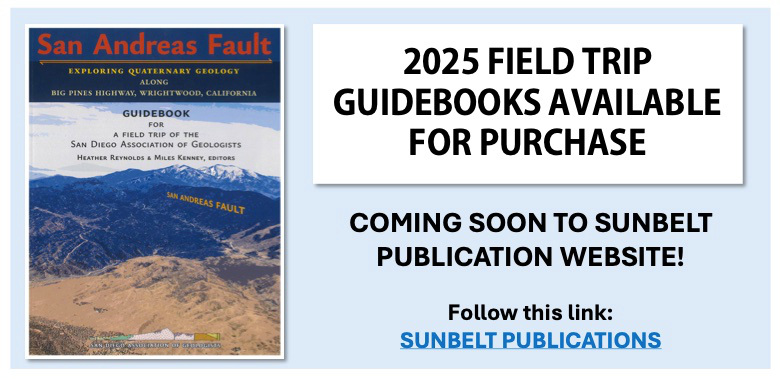
September Meeting review
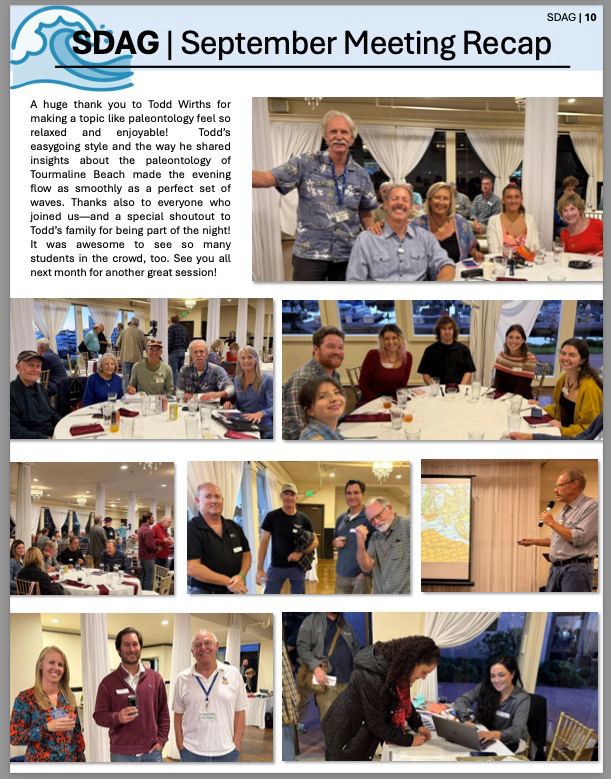
2025 SDAG MEMBERSHIP
Renew or become a new SDAG Member - 2025 Member Dues are Due!
On-line Payment ($30 Member; $10 Student):
https://www.sandiegogeologists.org/MemberForm.pdf
Mail in or Bring FORM to Meeting:
https://www.sandiegogeologists.org/MemberForm.pdf
2025 Corporate SDGS Sponsors
Renew or become a new 2025 SDAG Sponsor - Minimum $100 includes annual Membership.
https://www.sandiegogeologists.org/Sponsors.html
On-line Payment or Mail in Form:
https://www.sandiegogeologists.org/SponsorForm.pdf
CALL FOR PAPERS
From Past President Jennifer Morton:
Hello Geo Community! I am currently working on my Master's degree at SDSU. Part of my thesis will include compiling a
geodatabase of investigations on the La Nacion fault system. If anyone has done any trenching or other work on the
fault and is willing and able to share the information I would greatly appreciate it! Thank you and Happy Holidays!
Geology field trip to Iceland with GeoTours 2026 - Info and Sign Up
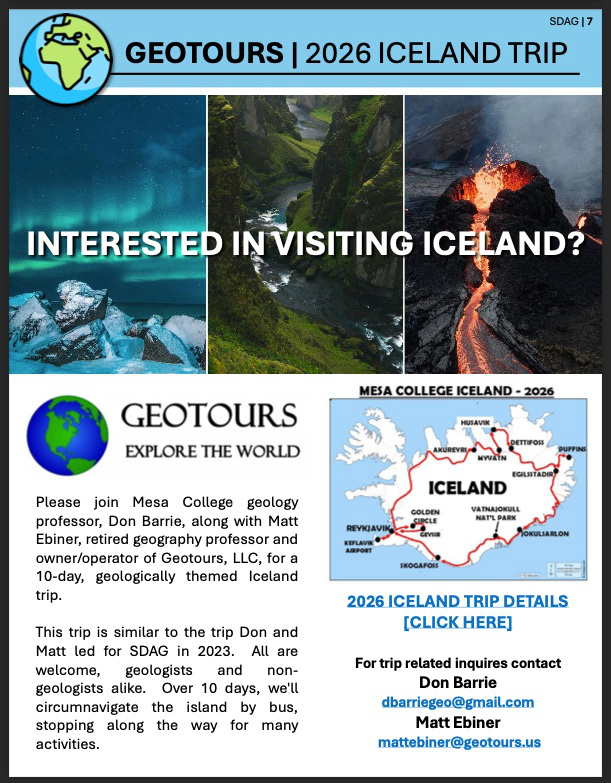
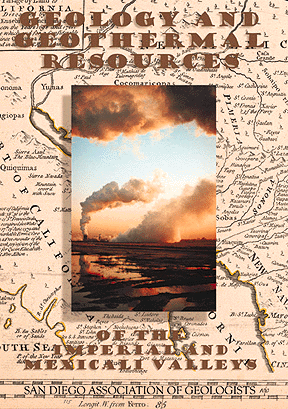
Publications
Based on the interest for the out of Print 1998 SDAG Book "Geology and Geothermal Resources of the Imperial and Mexicali Valleys" this book
is now available as a Google E-Book. Due to the age of this book, not having any electronic files, the need to update to color etc...
the decision was made to create an e-book from a scan of the book. The link to purchase this book is now live on the SDAG website
(Lowell Lindsay's 1998 Geothermal Book!).
Here is the link to the SDAG Publication web page https://www.sandiegogeologists.org/Publications.html and a screen shot below showing
this E-Book. Thanks for the donated book from the Lindsays, Dave Bloom for scanning the book and posting it on our Google E-Book site,
and Carolyn Glockhoff for adding the link to our SDAG Publication page - now this out of print book can now be purchased as an e-Book!
In the news ...
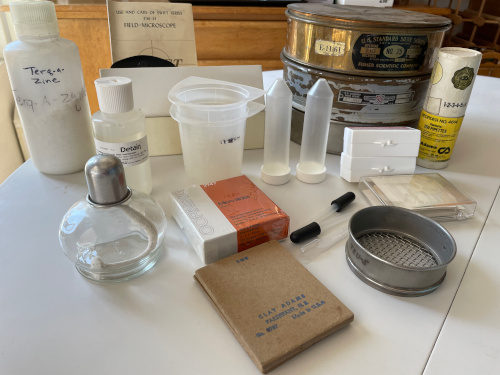 Palynology Library & Equipment Donation Palynology Library & Equipment Donation
Norrie Robbins is generously donating her palynology library, posters, and some microbiology/palynology lab equipment.
If you're interested, please contact her directly:
619-890-3696 or norrierobbins@cox.net
SDAG OFFICERS /SDGS BOARD OF DIRECTORS - VOLUNTEER OPPORTUNITIES
If you are interested in the structure of SDAG/SDGS, serving as a SDAG Officer, or serving as a
Director, please read the information that follows. SDAG currently has an Officer position opening for
a 2025 Vice President.
In the fall of 2008, a group of the SDAG past presidents formed a Board of Directors to create a non-
profit corporation. This new organization was created as a 501(c)(3) non-profit Corporation. Once the
San Diego Geological Society, Inc. (SDGS) was created, the SDGS Board formed a standing
committee of SDAG Officers and members. On February 7, 2022, SDGS recorded a fictitious business
name statement, doing business as (dba) SDAG. The benefits of a 501(c)(3) Nonprofit Corporation
Status are: Profits are exempt from corporate income tax and qualify for other tax exemptions; Proper
management of SDAG publication sales and sales tax reporting (Field Trip Guide Books; Short
Courses); Individuals can make tax deductible contributions (ex. Sponsors, Scholarships, books, or
other donations); Can obtain better rates on event liability insurance for events (ex. Meetings, Field
Trips); Personal liability protection for officers and organization as a whole (ex. Field Trips, One Stop
Wonders); Allows a legal structure that helps to expand our activities (ex. Educational trips); and Tax-
exempt status is required for many public and private grants (Future opportunities). SDGS has a
broader "public" scope as a non-profit. SDGS also well reflects what SDAG does, i.e., publish
geological books, support students with scholarships, lead field trips, and organize other activities of a
public and educational nature. The structure of the SDAG/SDGS organization is:

See SDGS Articles of Inc & By-Laws for the Non-Profit: http://www.sandiegogeologicalsociety.org/
SDGS is governed by a six-member Board of Directors elected to 2-year terms, three in even years
and three in odd years. The Board currently consists of those listed above. Former board members
include Dave Bloom, Greg Cranham, Mike Hart, Lowell Lindsay, and Bob Stroh.
If you are interested in serving as the 2025 SDAG Vice President, please contact the current SDAG
President Heather Reynolds heather@sandiegogeologicalsociety.org.
If you are interested in any future positions on the Board of Directors, or if you have any questions
about the Board, you can contact Diane Murbach at diane@sandiegogeologicalsociety.org or any of
the current Directors listed above. Although there are no prerequisites to be a Director, the consensus
is that being a prior SDAG President provides the experience and understanding of the issues and
decisions a Director will face. Other qualifications include those with legal or financial CPA experience
to assist with the Corporations Non-Profit status.
ONE-STOP WONDER CHALLENGE!
ONE OSW A MONTH IN 2024
BE A PART OF SDAG HISTORY!
Have an idea for a one-day or half-day field trip?
Want to share your favorite aspect of San Diego geology?
Contact SDAG to schedule your One-Stop Wonder!
Your OSW may be chosen to be included in SDAG's One Stop Wonder Guidebook!
Contact Monte Murbach for scheduling! montemurbach@gmail.com
DID YOU KNOW THAT SDAG HAS A FACEBOOK PAGE?
Here is a link to the SDAG Facebook page: https://www.facebook.com/sandiegogeologists.org
As part of the update for the San DiegoTijuana Earthquake Planning Scenario, Working Group No. 1's "Fault Map Subcommittee"
completed the first publicly available bi-national active and potentially active fault map (http://sandiego.eeri.org/?page_id=265).
This interactive GIS map includes the first publicly available active and potentially fault map locations from the City of San Diego.
The map also integrated the faults south of the border for a bi-national cross border view.
This map is an on-going project as our knowledge increases about local active and potentially active faults.
You can expand the map legend on the left side to select layers that can be turned on or off for the map view.
You can also select from 1 of 12 base maps at the base map icon. You can click on the fault line in your map layer view to see the meta-data source.
In addition, the City of San Diego Seismic Safety Study Geologic Hazards & Faults Maps are available in the layer titled "GeoHaz SD City."
Please note that the City "Zone 12 Potentially Active" fault layers was not included in this data, therefore you will need to use the City Maps to find Zone 12.
The Fault Map link is available at: http://www.sandiegogeologists.org/Faults_map.html
I would like to thank Carolyn Glockhoff for her endless GIS work, Jim Quinn and the City for providing their data and time, Jerry Treiman with CGS for his time preparing the Surface Rupture
and providing their new State fault data layer, and Luis Mendoza at CICESE for providing the faults south of the border.
Please contact Diane Murbach (dianemurbach@gmail.com 619-865-4333), Chair for the SDTJ Earthquake Scenario Working Group #1 - Earth Science, if you have any questions, or see any errors on this new fault map.
Diane Murbach
(619) 865-4333
Engineering Geologist, C.E.G.
www.murbachgeotech.com
Photo of the Month
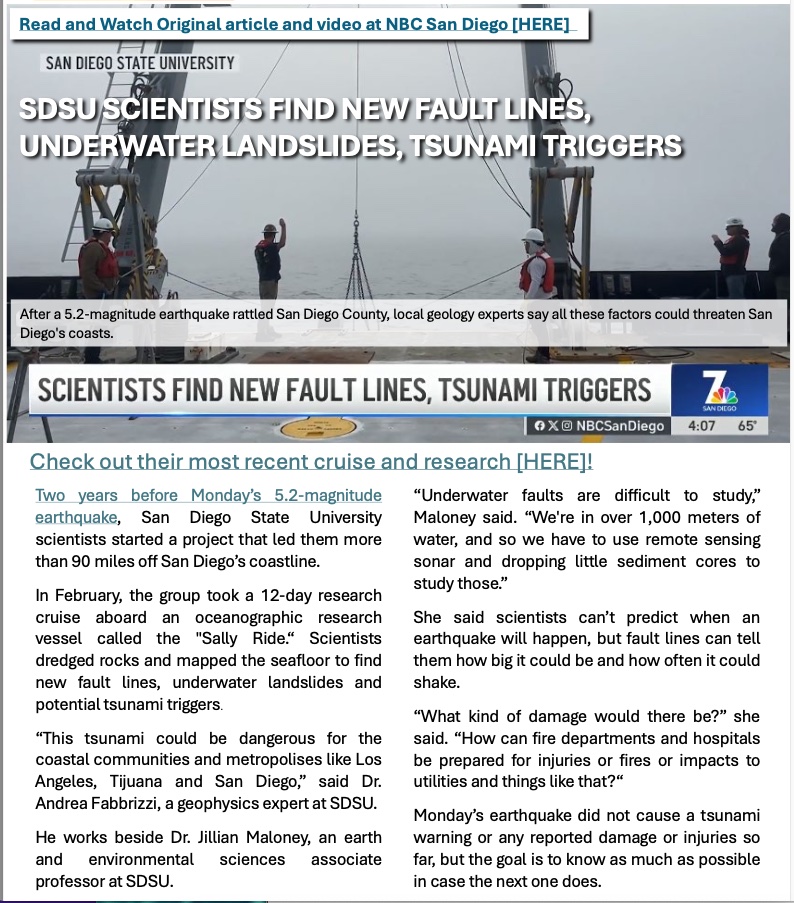
CALL FOR ARTICLES! SDAG invites members to submit articles on their current research or an interesting project they are working on for publication in the monthly newsletter.
The article should be no more than 1 page in length. Photos are welcomed, too! Please submit articles to the SDAG secretary via email.
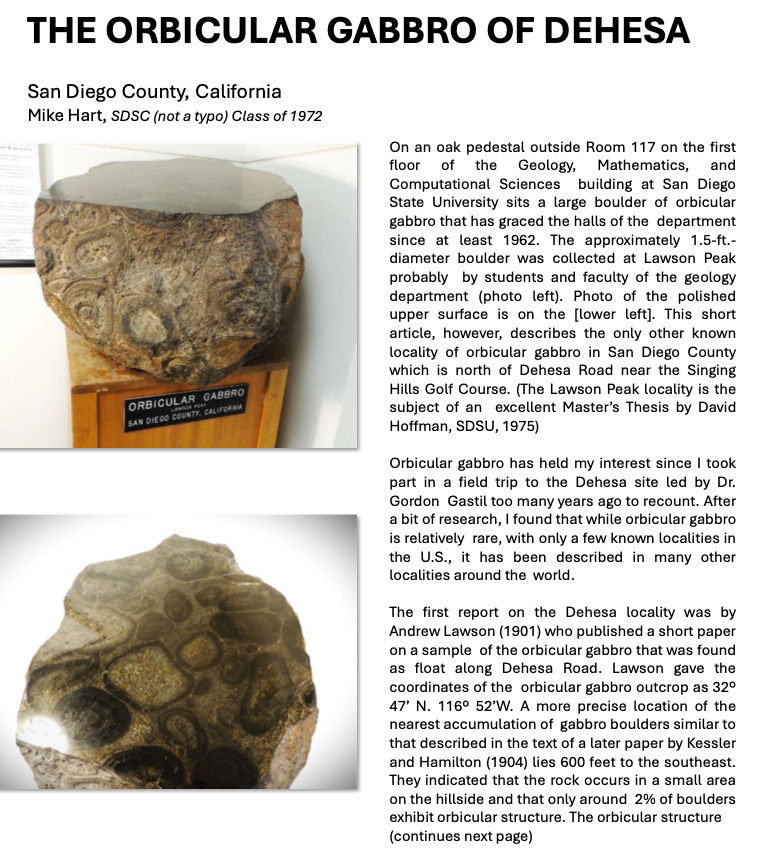
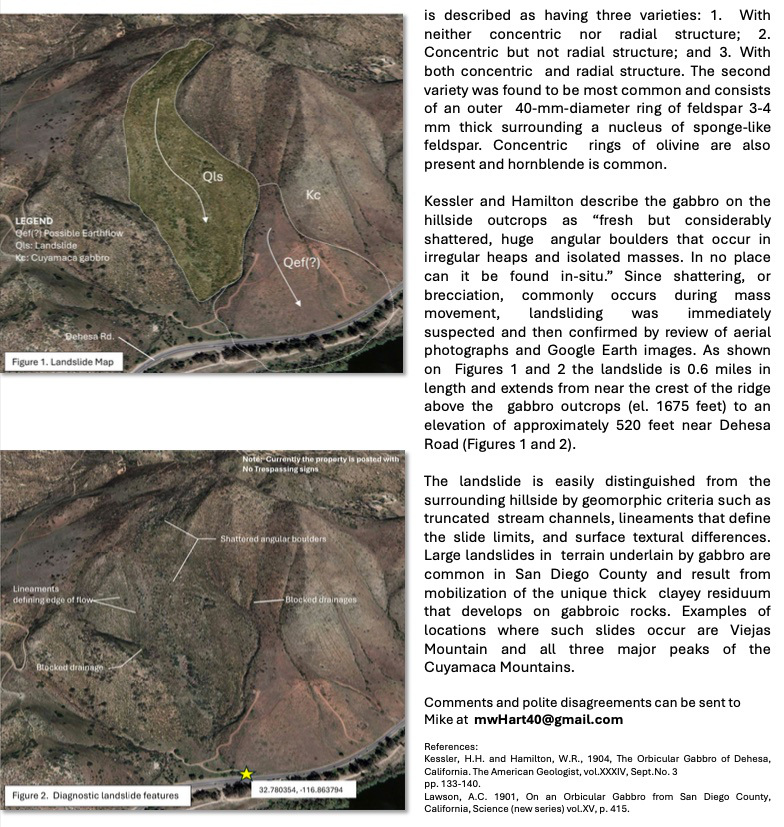
Yosemite Conservancy Outdoor Adventures featuring custom adventures.
Got too many rocks?
Are you (or specifically, your spouse...) interested in giving them a good home *away* from your house and garden?
Mesa College is looking to collect some rock samples for an inaugural Earth History course.
We are specifically looking for sedimentary rocks that include examples of different energy environments (varying grain sizes and shapes) and structures (ripples, cross bedding, planar bedding, graded bedding, etc.).
We are also looking to beef up our fossil collection and are looking for all the major phyla: Echinoderms, brachiopods, mollusks (bivalves, cephalopods, gastropods), arthropods (trilobites and more!), corals (Cnidaria), Porifera, Bryozoa, vertebrates (Chordata), etc.
Looking for both actual standalone specimens or in the rock still (showing different environments of deposition).
We are looking for fossil preservation examples, and also for good trace fossil evidence.
Got any sediment grain samples from cool locales? We'll take them! If you have anything else you think provides a good 'story' in the rock, we are willing to check it out!
We are collecting ASAP to assess how much needs to be ordered for the fall course.
Please contact Jill Krezoski at JillKski@hotmail.com or Don Barrie at dbarrie@sdccd.edu with queries or samples.
Annual Scholarship Awards by the San Diego Association of Geologists, a program of the San Diego Geological Society, Inc.
A primary function of the San Diego Association of Geologists (SDAG) is to support academic opportunities in geology and related sciences.
By-laws of the San Diego Geological Society (SDGS) specify the support of academic opportunity ranging from elementary through graduate levels.
The SDAG scholarship program has supported academic research in higher education by awarding scholarships annually to students from two-year and four-year undergraduate and master's level programs.
Awards are for outstanding research in geology and related sciences.
Nominations are solicited from individual faculty and from geology or related science departments at accredited academic institutions.
Evaluation of the relative merit of each nominee is based on an abstract describing the objectives and results of the research being conducted by the student and on the letter of recommendation by the student's mentor or nominating committee.
The annual timeline is as follows:
- Request for nominations occurs in September.
- Nomination letters and research abstracts are received by the Scholarship Coordinator in mid to late October.
- Awardees and their nominators are invited to attend the December SDAG dinner meeting. Scholarship awards are distributed to the student during the December meeting.
- Students accepting awards are required to give a presentation of their research results usually at a spring dinner meeting of SDAG.
For further information contact SDGS Board at
http://www.sandiegogeologicalsociety.org/contact.html
through the Contact Us option
SDAG RESEARCH TOOL
A comprehensive listing of all papers published by SDAG, whether as annual field trip guidebooks or special publications, is available on our website.
Entries are sorted by primary author, or chronologically by date of publication, from our first guidebook in 1972,
up the San Luis Rey River in 2013, from Coast to Cactus in 2014, and finally over the edge to the Coyote Mountains in 2015.
These can be accessed or downloaded as .pdf files.
They are fully searchable in Adobe Reader or Acrobat, so if you are researching a topic, "tsunami" for example,
you can search for that keyword. This listing will be updated as new books are published.
Thanks to Greg Peterson and Hargis + Associates, Inc., for making this possible.
See the links below:
SDAG publications sorted by senior author.
SDAG publications sorted chronologically.
Request for Sponsors: 2025 SDAG/SDGS and Publication SPONSORS
On behalf of the San Diego Geological Society, Inc. (SDGS), a public benefit 501(c)3 nonprofit
educational corporation, we would like to request tax deductible Donations at our San Diego Association
of Geologists (SDAG).
The list of paid Sponsors and the forms to become a Sponsor are located on the SDAG web site at:
http://www.sandiegogeologists.org/Sponsors.html.
Your donation will further the SDGS mission to promote geology and related fields in the greater San
Diego region, operating through the San Diego Association of Geologists (SDAG), a committee of
SDGS. To achieve our primary educational objective, we organize frequent field trips and maintain a
program of monthly meetings featuring speakers on current geological topics. We also publish field trip
guidebooks and other publications related to geology and natural history. We encourage scholarship and
research by awarding scholarships from the elementary through graduate levels. With your $100
"EMERALD" donation, your name/business will be listed as a sponsor on the SDAG web site
(http://www.sandiegogeologists.org/) and in the monthly SDAG meeting newsletters. With your $500
"RUBY" or $1,000 or more "DIAMOND" level donation, your business card will also be included on the
SDAG web site and in the monthly SDAG meeting newsletters. In addition, as a "$1,000 or more
DIAMOND" level donation you will be presented with a thank you plaque.
Should you have any questions
regarding a Sponsorship, please contact our non-profit SDGS Secretary (Diane Murbach) at 619-865-4333.
SDGS/SDAG
As many of you are aware, the San Diego Geological Society (SDGS) was formed in early 2010 as an
official non-profit 501(c)3 corporation, and SDAG is now an organization under this corporation. The
reasons for doing this were many and they are spelled out in an informational sheet, the Business Plan
of SDGS. The officers of SDGS should be very familiar to you, as they are all past presidents of SDAG.
For those of you that would like to read more about SDGS and what it means to SDAG, check out the
informational page on the website.
Also check out the website www.sandiegogeologicalsociety.org.

VINTAGE SDAG GUIDEBOOKS NOW AVAILABLE FOR FREE DOWNLOAD!
If you want to complete your collection, or just see what SDAG was up to in the 1970s, check out our website's
publication page, and scroll all the way down: http://www.sandiegogeologists.org/Publications.html
In addition to our very first publication in 1972, a field trip to Otay Mesa, you'll find our 1973
Geology and Hazards of San Diego volume, the first of two guidebooks to the Coronado Islands, in
1978, and our 1987 field guide to the gold mines of Julian. Happy reading!
SDAG Wear - Monte (Murbach) has a variety of shirts, hats, visors and even a nice vest with the SDAG logo.
A small selection is available for purchase at the meetings; all SDAG wear can be ordered from Monte.
DO YOU HAVE AN ANNOUNCEMENT?? Do you have an event, job opening, field trip or other announcement you would like to share with our members??
Just call or email our SDAG Secretary.
Wednesday seminars, 1 - 2 pm, SDSU in the Chemistry-Geology Building, room CSL-422.
Check http://www.geology.sdsu.edu/seminars/ for details.
Department of Geological Sciences
San Diego State University
San Diego, CA 92182-1020
FAX (619) 594-4372 VOICE (619) 594-6394
The Gordon Gastil Endowed Scholarship Fund continues to seek donations of any amount.
Gifts of $ 500.00 or more will be recognized on a plaque to be placed in the remodeled Geology Building.
Donations can be sent through SDAG, or contact Pia or Marie, Department of Geological Sciences, SDSU, at (619) 594-5586.
SDSU-AAPG student chapter officers intention is to support student interest in petroleum and geology related fields.
Association of Environmental and Engineering Geologists
AEG Inland Empire Chapter
The SCGS usually meets on the first Monday of every month, in Orange County. For more SCGS information, visit their website at:
http://www.southcoastgeo.org.
Our website manager, Carolyn Glockhoff, can create a link from any Corporate Sponsor's listing on the SDAG website to its company website, if one exists.
Also, please send the URLs of your favorite geology sites to carolyn@caro-lion.com for listing on the Geologic Links page.
These could be data resources, schools, useful government contacts, geologic software, contractors, laboratories, your own company's website, or anything you think would be useful to your colleagues.
DO YOU HAVE AN ANNOUNCEMENT?? Do you have an event, job opening, field trip or other announcement you would like to share with our members??
Just call or email 2023 SDAG Secretary.
Any news regarding upcoming events that may be of interest to the Association or news of your business can be submitted.
|





